AVENGERS VS. X-MEN #1 ($3.99, Marvel Comics)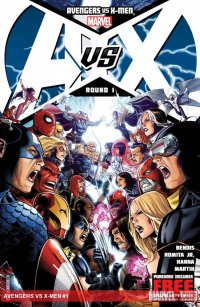
By Devon Sanders
The term, “It is what it is” never rang truer than for the idea behind Avengers vs. X-Men.
A major, MAJOR threat is set to visit and possibly destroy Earth. The Avengers, who have seen and fought against this thing before, view it as an extinction level event. The Avengers, well-versed in the extinction level event want to stop said event. A member of The X-Men may be the vessel for which this event may occur.
The mutant X-Men, diminished by an near-extinction level event caused by former Avenger The Scarlet Witch, view its coming as something of a blessing and mutantkind’s last, best hope. So, The Avengers and The X-Men stand ready for a showdown. And they fight.
Conflict. It’s what Marvel does best and it’s done superbly with the pages of Avengers vs. X-Men #1.
Avengers vs. X-Men is the culmination of… well, EVERY major Marvel event over the past few years, tapping into the events; Avengers: Disassembled, House of M and the X-Men-centric Second Coming. Despite its being dependent on nearly a decade’s worth of continuity, Avengers vs. X-Men #1 does its job setting up the history of conflict and past camaraderie between Marvel’s two most storied teams.
Five writers, Brian Michael Bendis, Jason Aaron, Matt Fraction, Ed Brubaker and Jonathan Hickman are credited with writing this issue and the collaboration is more a statement of who these men are to Marvel as a whole. The dialogue hits well and plays well with the various divisions running between the two teams, especially a conflicted Wolverine caught between being an Avenger and an X-Man.
Art chores for this issue are handled by Marvel mainstay John Romita, Jr. and his work hasn’t looked this good in a while due mainly to his reunion with inker Scott Hanna. Hanna brings a nice polish and sheen to Romita’s work and every character is perfectly spot-on in their every action and gesture.
Again, Avengers vs. X-Men #1 is what it is; an eventuality. This one could easily have been phoned in but what you get is a well-written, well-drawn reward for longtime Marvel readers. It truly reads like the comics event of the summer and so far, delivers on its premise and promise.
Rating: 




Out of a Possible 5 Stars
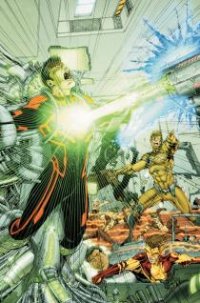 Teen Titans #7 (DC, $2.99)
Teen Titans #7 (DC, $2.99)
By D.S. Randlett
There’s a scene in Arkham City where Robin shows up to give Batman some new piece of gear, basically to get ridiculed. This was pretty indicative of where the character stands with a lot of Batman fans: He’s that annoying kid who thinks he’s Batman’s friend. Correction, Boy Wonder, Batman is nobody’s friend. At least, that’s what he tells himself when no one returns his calls.
That was never a vision of Batman, or Robin, that I really embraced. Sure, Robin doesn’t necessarily belong in every Batman story, but why reject the stories where Robin fits? I always liked Robin in his various iterations, and to some degree what he represents in Batman’s world. While one could question the wisdom of putting a child in peril, in terms of the Batman narrative Robin represents Batman embracing his future instead of simply dwelling on his past. There is certainly room for stories where Batman is a loner who is constantly addressing his past, but the Batman legacy characters open up other dimensions of the character that feel just as “right” as the pathological loner stories.
I think the same goes for the other legacy characters that we got to know in the last version of the DCU. It’s easy to ridicule the sidekicks, but when handled well they can be honest reflections of children. When they are the protagonists, they can reflect the angst of adolescence or feelings of youthful inadequacy. When they are seen under the gaze of adult superheroes, they can reflect the concerns and worries of being a parent. If superheroes are the modern mythology, perhaps the sidekicks were inevitable, at once encapsulating how it feels to have kids and how it feels to be a kid.
Which brings us to the new Teen Titans. One thing is apparent: they are trying really hard to make these characters not feel like sidekicks. As of the seventh issue of Teen Titans, the team hasn’t even properly coalesced yet. Three of our main characters are all new, and the sidekick characters (with the exception of Red Robin) don’t seem to have any relationship at all to their adult forebears. The latter presents a pretty serious problems given the apparent goals of this book in the new DCU.
I find it kind of amazing that Teen Titans and Superboy are both written by Scott Lobdell. In terms of plot, they are pretty intimately connected, but the difference in tone is night and day. Superboy is actually one of the bigger surprises of the DC relaunch for me. It manages to take full advantage of the sidekick conceit, even though Superboy (Superman’s clone here) hasn’t met Superman yet. But still, Superman’s shadow hangs over Superboy almost constantly. There are characters hoping that he’ll act like Superman, others hoping that he doesn’t. More than that, Superboy weaves the things that the Superman concept has to say about adolescence into a different context, and in doing so it actually manages to be a humane and affecting story with some appealing characters at its center.
Teen Titans is kind of a mess. It’s a punchier comic than Superboy, and it’s more concerned with having its characters engaged in big fights, both with each other and with villains. The story ends up being rather thin as a result, and Lobdell’s adoption of a quippier Whedon-lite style of writing doesn’t do much to cover up how shallow Titans is. With Johns’ Justice League, I kind of get it. There, pretty much everyone has their own book, so JL is more or less free to be a big, fun punch-up. Want to get inside Wonder Woman’s head? Pick up her book to find out. Titans doesn’t have that luxury, the only character with his own book is Superboy, but it mimics that tone nonetheless. This is a shame, as Lobdell has a genuine gift for coming up with big superhero moments, but the scheme he’s come up with for Teen Titans keeps any of those moments from registering the way that they could. The conspiracy involving an organization called N.O.W.H.E.R.E. gets lost in all of the punching, and character motivation along with it.
The art in Titans fits the tone, and that’s about the best that I can say for it. It feels very nineties, but also very vibrant and energetic. It does what it needs to do, but it feels very tasteless. Very much of the Jim Lee school, Brett Booth’s pencils will immediately draw the eyes of the eight to thirteen year-old boys in your life.
The biggest problem with Titans is its desire to eat its cake and have it too. It wants to exploit its legacy connections while its characters actively distance themselves from their adult forebears. Superboy and Kid Flash have never met Superman or The Flash, respectively, and Wonder Girl really doesn’t like Wonder Woman for some reason. The book wants to establish them both as established icons and teenage runaways, a set of conflicting goals if I’ve ever seen any. There was something subtle in the way that the original Titans treated being a teenager. Characters like Robin and Speedy wanted to be their own superheroes, but they also wanted to respect and be proud of the traditions that they were a part of. There’s always been something inauthentic to me about teenaged characters who want to burn all the maps, which is how these modern Titans have so far been written. There are exceptions here and there of course, but in the context of Teen Titans’ story, these moments feel like accidents rather than actual character moments.
Teen Titans is a mostly bad book with some good, fun touches, but it just feels ends up feeling inauthentic. Those itching for teen superheroics might want to check out Superboy instead.
Rating: 




Out of a Possible 5 Stars
Bloodstrike #26 (Image Comics, $2.99)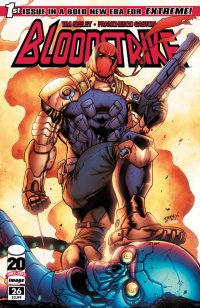
By Bart Bishop
Image Comics is in my blood. It’s a part of my upbringing as a comic book fan. I starting collecting in the late ‘80s, and my brother and I were Marvel fanboys through and through, so our idols were Todd McFarlane, Jim Lee, Erik Larsen, and of course Rob Liefeld. My brother Stuart was more of a Spider-Man guy, whereas I was an X-Men (and Wolverine) kind of guy, but we did a lot of swapping and we still fondly joke about those days. I have to admit, I saw a trade paperback of Spider-Man: Torment at Barnes & Noble the other day and got a little choked up. So, in 1992, when those hotshots started their own company I followed them over, and at a tender age was caught off guard by the heightened violence and language, and overt sexuality, depicted in such four color glory.
It’s a sign of how I’ve changed, however, as a person that what I look for now as a fan, and critic, is an engaging script with snappy dialogue, solid characterization, and an immersive plot. Rob Liefeld, however, has never excelled in any of these departments (his art is a whole other story). Take his creation, Bloodstrike: first published by Liefeld’s Extreme Studios in 1993, the series originally depicted a top-secret, super-powered, living dead assassination squad deployed covertly by the United States government. Brought back to life by the government’s Project: Born Again, the team’s exploits ran for 22 issues. The added notoriety came with the special issue 25, printed early in the title’s run as part of a crossover event that ran through several titles being published by Image at the time. Issue 25 was noted for depicting a solo Bloodstrike character, team leader Cabbot Stone. Issues 23 and 24 have not been published to this day.
With Liefeld’s renewed partnership with DC Comics, Extreme has been bringing back old characters, such as Prophet and Glory, recently. Bloodstrike continues the trend, picking up with issue 26. The difference, however, is that while Prophet and Glory are reboots, Bloodstrike is continuing from the older storyline. According to solicitations, “Extreme’s zombie-black op-superheroes return! Cabbot Stone is the last unliving Bloodstrike agent, an unstoppable weapon in America’s war on terror! But being dead is a hell of way to make a living, and Cabbot is losing his faith. Will his latest mission be his last? Bloody horror-action with heart by Hack/Slash writer Tim Seeley and Artist Franchesco Gaston!”
First of all, let’s talk about Bloodstrike as a character. Visually, now and back in his heyday, he is a ripoff of Deadpool. In many ways, he is the culmination of ‘90s escalation, with the kind of giant shoulder pads and six foot long rifles Liefeld loved to fetishize. For the sake of setting him apart, however, in #26 his mask gets ripped open, exposing his mouth and chin. The rest of the outfit has been relatively toned down. Characterization wise, he is nothing like Deadpool. I can’t speak for the earlier writing, but here Seeley has found an interesting spin on his personality: Bloodstrike, having died and been brought back to life, is an atheist.
Let me preface this by saying I’m not the biggest fan of Seeley as a writer. Having read the first two volumes of Hack/Slash, I feel like he tends to target the lowest common denominator of T&A and homages to similar properties. Here, however, he has a much more po-faced approach (the therapist’s reaction to Bloodstrike’s atheism is cringeworthy ridiculous). There is very little in the way of pop culture references, and the plot is suitably grim & gritty, but there is humor, such as the dialogue of the android Bloodstrike fights. A nihilism runs through the narrative, however, as Bloodstrike’s atheism is played as a hitting-bottom, hopeless situation. The odd thing about this whole conundrum, which in of itself could be fascinating to explore, is Seeley makes it a point to reference the character of Chapel, who is best known for having killed Al Simmons, who ultimately returns as the demon-powered Spawn, and then kills himself in order to achieve the same power. Bloodstrike lives in a world that is continuously bombarded with the supernatural, and is colleagues with people that have actually been to Hell. How can he be an atheist? Still, a series should be judged on its own merits, but I worry that Bloodstrike’s atheism won’t be treated as a fascinating character tic but as something to overcome (such as my colleague, D.S. Randlett, discussed several months ago here).
The artist by Franchesco Gaston has a cartoony, but very effective, style, reminiscent of Pascual Ferry. His angular style creates just enough distance from reality to make the silly super powers and costumes acceptable, but incorporates unique fashions and facial expressions that have the characters stand out. His use of paneling has a jagged, overlapping quality to it that mimics Bloodstrike’s state-of-mind: The issue starts off with Bloodstrike in a forced therapy session, and he’s unhinged to say the least. I appreciated the repetition of similar images, but with each successive image the look on a character’s face would drop in sadness or rise up in anger. The cover by Seeley and Carlos Badilla, meanwhile, is appropriately over-the-top, with Bloodstrike striding atop a conquered robotic foe. It isn’t terribly evocative of the sense of ennui and melancholy that infects the pages, but it does its job, in classic Image fashion, of bringing the spectacle of explosions and chiseled poses.
It certainly is Extreme! The premise is by-the-numbers, and I have to admit to feeling ennui myself at the assembly line of killers in costumes that mainstream comics have been serving up these days, but there’s enough of a unique spin here to make it worthy of a read. It’s strange, in retrospect, how a company created by artists (the epitome of style over substance) has over the years been so embraced by talented writers. The likes of Neil Gaiman, Alan Moore, and Joe Casey have all salvaged previously clichéd characters, and although I wouldn’t put Seeley in their ranks he has managed to do something I thought impossible: make Bloodstrike entertaining.
Rating: 




Out of a Possible 5 Stars
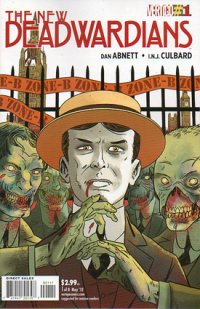 THE NEW DEADWARDIANS #1 (Vertigo, $2.99)
THE NEW DEADWARDIANS #1 (Vertigo, $2.99)
By Adam Prosser
Well that meme sure exploded fast, huh?
A while back, there were a handful of articles online—I think Cracked.com may have been the first, but don’t quote me—drawing a connection between the fluctuating popularity of zombies and vampires, respectively, and their relationship to the political spectrum. The argument, reasonably enough, was that the two most popular undead monsters reflected different aspects of what people were concerned about during times when politics swung to the left or right. If that description sounds a little vague, it’s because I’ve heard both zombies and vampires argued as standing in for both Republicans and Democrats—vampires could be seen as a thinly-veiled metaphor for the right’s supposed corporate cronyism or the left’s supposed deviant elitism, and zombies could be an exaggeration either of the right’s fear of the unruly masses or the left’s fear of mindless conformity. The fact that this is such a hard metaphor to pin down should tell you how hard it is to take seriously, but nevertheless, there IS a pretty obvious groundwork for a metaphorical horror series here, and writer Dan Abnett and artist I.N.J. Culbard have stepped up to the plate with The New Deadwardians.
Eschewing the more overt political split, this comic goes for the more obvious “vampires are the upper class, zombies are the plebes” parallel. In an alternate-history 1910, a plague has created the familiar army of mindless undead, known here as “The Restless” (what is it with zombie stories lately being allergic to the word “zombie”?) Mostly confined to a barricaded section of London called Zone B, the Restless nevertheless aren’t as contained as they could be, as we see in the opening pages, when a lone Restless invades the home of Inspector George Suttle and makes a meal of his housekeeper. Suttle himself is able to polish off the undead invader with no problem, though, since he’s immune. As it turns out, there’s a “cure” that renders one safe from zombification, though it seems to mostly be the province of the upper class, and also has the unfortunate side effect of turning you into a vampire. Of course, on the one hand, this means you’re now a dead person anyway, and can’t go out in the sun, but at the same time, you get to “live” forever, and you can only be killed by the traditional stake through the heart, decapitation, or burning.
Except…Suttle just stumbled on a vampire corpse that didn’t have any of those three things happen to it. Is undeath suddenly getting more dangerous in London?
If you’re not utterly sick of vampires and zombies yet (and somehow, I’m not), Deadwardians provides a neat, hooky premise and a solid execution. The world of the story is efficiently set up and the premise invites further speculation. It’s a long way from perfect, though. In particular, Abnett leaves some oddly lingering questions about the rules of undeath. In particular, it’s not clear to what extent the upper-class vamps become the monsters of legend—they seem to require blood, but they shave down their teeth, and at one point a doctor asks casually whether Suttle is experiencing any “cravings”, so presumably they don’t just go around feeding on the masses. Obviously I expect answers to be given in due time, but it does make this issue seem a little unbalanced, with the zombies being given a pretty clear delineation and the vampire aspect being given so little page time (you don’t even see anyone drink blood in this issue). Then there’s Culbard’s artwork, which is oddly stiff and sparse, more like an indie comic than something from a major publisher—though of course to an extent it suits the subject matter very well. If the real-world Edwardians were stiff, drab and mannered, a society of undead ones would be even more so, and these are all qualities conveyed in spades by the artwork.
In the same fashion, the story itself is hardly bursting with freshness or pulse-pounding originality. It’s a deeply familiar set of tropes, even with a story as deftly set up as this one. Yet the fact that it manages to work as well as it does within the confines of such a well-trod genre is a commendation in and of itself. The Edwardians inhabited a British Empire that was already dead but still hadn’t realized it, whose best days were behind it but still had momentum; replace “British Empire” with “genre” and you’ve described The New Deadwardians as well. But, also like the Edwardians, it continues forward with formality, seriousness, and a stiff upper lip. VERY stiff.
Rating: 




Out of a Possible 5 Stars
Atomic Robo Presents Real Science Adventures #1 (Red 5, $2.99)
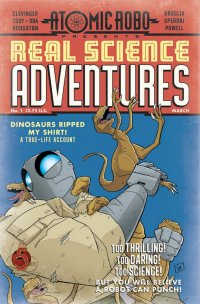
By Jeb D.
Everyone says that comics “used to be good,” and while that’s very much a matter of taste, there’s no question that the darn things used to be cheap. Yeah, I’m old enough to remember when they came for the price of the change in your pocket, and while inflation is a very real factor in price increases, there was a time when taking a chance on a new comic was mostly a case of shrugging “eh, why not?” and tossing a few extra coins in the counter. That’s obviously no longer the case, and today’s reader tends to want confidence that his entertainment investment (whether in comics or elsewhere) comes with a guaranteed payoff.
Thus the difficulty of marketing this new ongoing sampler comic series from the good folks at Red 5. The fact that there are five different stories (or portions of stories), all scripted by Atomic Robo creator Brian Clevenger, increases the odds that you’ll like something… but at the same time, it means that there actually isn’t very much of whatever your favorite story here is, and each reader has to decide for themselves just what percentage of that three bucks they’re willing to shell out for the stuff that doesn’t grab them as much.
The collection opens with Part 1 of “To Kill A Sparrow,” with art by Ryan Cody (Villains). It’s a tale of WW2 espionage, with a costumed heroine known as The Sparrow infiltrating a Nazi lair in Vichy France. Its six pages are less the beginning of a story than a character introduction, but the plotting is effective given the compression, and the setup for Sparrow’s ongoing series contains a bit of a twist I’ll leave for readers to enjoy. Cody’s angular art is appropriately dark (Nazis, remember). As a curtain-raiser, it’s effective enough, though I would think an ongoing series would work better as a full-length comic rather than being served up in bite-sized chunks, as seems to be the plan.
“The Revenge of Dr. Dinosaur” is an amusing Atomic Robo three-page skit with art by Yuko Oda (evidently regular Atomic Robo artist Scott Wegener is otherwise occupied), who if I’m not mistaken is known primarily as a “fine” artist and painter. Whether or not I’ve got her mixed up with someone else, the art in this segment is the most delightful in the book, though the script isn’t particularly sequential, with the result being mostly a series of static (though appealing) panels leading up the groaner of the punchline.
“City of Skulls,” with art by Chris Houghton (Image’s Reed Gunther), is a four-page vignette that finds Atomic Robo in post-Soviet Siberia, encountering a sort of Red Guardian counterpart to himself, and settling their potential conflict by being reasonable. I guess the ending could be a bit poignant if we’d actually had time to get to know the Russian robot.
“Leaping Metal Dragon, Part 1,” with art by John Broglia (God Complex) is four pages that kick off (so to speak) a 1970-set story with Atomic Robo teaming up with Bruce Lee. Really, that’s about it: the story itself might or might not be fun once it gets going; the art is genial and cartoony.
“Rocket Science is a Two-Edged Sword,” has art by Joshua Ross, whose work is new to me, though there’s a sort of European/indie feel to his black and white pencils. It’s a 1940’s encounter between Atomic Robo and a villainous wizard aboard a crashing spacecraft, whose four pages end on a dryly underplayed note that’s sort of the visual equivalent of a shrug.
Fans of Atomic Robo will recognize that feeling: the series’ strengths have always been quiet understatement, and an unusually thoughtful approach to the inherent absurdities of comic-book storytelling. There are hints of it in most of the character’s appearances here, but the anthology nature of the book doesn’t allow it to sustain.
By the way, if you’re wondering why my individual page counts don’t add up to the listed 26, Red 5 precedes each story with a full title page; while it does provide a nice transition from story to story, anyone computing cost per page might want to bear that in mind. And since we don’t get a lot of free comics to review here at Thor’s Comic Column, I should also mention that I was actually able to review a free pdf of this book, which means my evaluation is probably a bit more generous than it might have been if I’d had to pay for it. It’s all quite nice, but I suspect most readers would find their money better spent on one of the complete-story Atomic Robo collections that are currently available, and telling the folks at Red 5 that a full-length ongoing from The Sparrow would be most welcome.
Rating: 




Out of a Possible 5 Stars
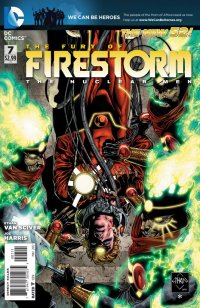 The Fury Of Firestorm: The Nuclear Men #7
The Fury Of Firestorm: The Nuclear Men #7
by Graig Kent
Half a year into “The New 52” and we’re in the throes of, I guess, “phase 2” wherein the books that are obviously not working (or selling) are cancelled, the books that should be working better are getting shaken up with new talent, and the creators who have had second thoughts about their role in the reboot are title hopping or title dropping. If DC didn’t actually have fairly solid structures to roughly half of their books, the whole thing would be a fiasco.
The ungainly titled The Fury of Firestorm: The Nuclear Men is one of the problem children. It hasn’t exactly received the best of receptions under the tandem of Ethan Van Sciver and Gail Simone. There was initial excitement over the pairing of the superstar duo, but that fizzled rather quickly. The whole idea of two Firestorm (apparently, like moose, there is no plural of “Firestorm”) — both Jason Rusch AND Ronnie Raymond — was carried over from Brightest Day, something I didn’t much care for then either. It seemed redundant having two of them. I had a skim through this title’s first issue when it came out and was quite comfortable putting it back on the shelf and not thinking about it again for the very same reason. From the buzz surrounding the book (or lack thereof), it certainly didn’t feel like I was missing anything.
Rumor was Simone had “editorial conflicts”, which never results in the strongest finished product, and ultimately she elected to leave the title (as was announced way back in October). Replacing her is Joe Harris (recently of his creator-owned Ghost Projekt and Spontaneous at Oni) acting as writer and co-plotter with Van Sciver. Van Sciver, in turn, is illustrating the current storyline, which, given his profile as an artist, is about the best thing he could do if he wants to raise the title’s profile and resurrect its sales (and, perhaps, critical and fan reaction).
While Van Sciver’s painstakingly detailed art is attractive and powerful (with some downright gorgeous color work from HiFi), by itself it can’t make a book work. Despite the creative shake-up, there remain weaknesses in the foundation of the book that lead to a shaky few pages that even Van Sciver can’t put a pretty edifice on top of. The whole “Zithertech” element is the roughest part, and it obviously plays (or played) a large part in the story of Ronnie and Jason’s transformation into Firestorm, but it’s clunky, and Jason’s interaction with “Director Zither” is likely a necessary two pages of transitional exposition but it’s still the weakest link.
Harris does what he can with the dangling elements that were left over from the previous six issues, but it’s quite evident that he has a story he’s interested in exploring and that’s where the fun begins. His script is dripping with Cold War sentimentality without forgetting about the “new war” on terror. Ronnie, flying solo, heads flame-first into a trap somewhere in the middle east, where a mad scientist and his team are exceptionally curious about learning the secret of the “Firestorm Protocols”. Essentially, creating Firestorm is the new arms race (and apparently an old one too, if the appearance of Russian Firestorm Pozhar is any indication) and he who has the most Nuclear Men wins, I suppose.
What Van Sciver does with the torture sequence and Pozhar’s interference is just wonderful comic book stuff, loaded with super-science and visual effects that would cost millions to render for live action. It’s comic books doing what comic books should do, bringing the unreal to life. Harris, for his part, brings the audience up to speed, for the most part, without dwelling on what’s come before. He gives you just enough to draw you into the story without giving you everything, and meters it all out nicely so that it’s not so overwhelming. Harris seems to have an immediate voice for Ronnie, loading up heavily on his personality, while, unfortunately, Jason just seems to be doing a lot of scowling right now.
It’s not perfect, but it has a definite sense of direction, and it’s already building momentum. It still may not be what old school Firestorm fans are expecting but this issue is a good step towards brighter days for ol’ flame head.
Rating: 




Out of a Possible 5 Stars
B.P.R.D. Hell On Earth: The Pickens County Horrors #1 of 2 (Dark Horse, $3.50)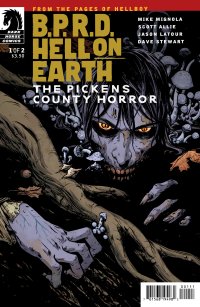
By Jeb D.
Because my reading comprehension is evidently not what it might be, I had thought that Becky Cloonan was actually illustrating this latest BPRD tale, rather than just doing the cover. So I have to admit that, for me, the book starts off with one (totally unfair) strike against it.
Continuing the “Year of Monsters,” Pickens County Horrors (with story by Mignola and script by Scott Allie) introduces us to one of those creepy backwoods families so beloved of horror comics and movies with their own unique twist; a pair of BPRD field agents, Vaughn and Peters; and vampire researcher Professor Ethan Thomas. In the wake of the plague that has driven much of the Hellboyverse lately, the agents’ nocturnal investigation (after they ignore the usual warnings about how their destination is prone to unspeakably mysterious dangers) are exposed to a gas that conceals monstrous enemies, knocks them out, and leaves them with some nasty side effects. When Vaughn awakens, he and Peters are in the care of Thomas, who fills him (and us) in on some vampire lore, and starts to connect some of the puzzle pieces. My only real reservation is that the setup for Thomas to give us the necessary exposition is Agent Vaughn’s seeming skepticism about an impending vampire apocalypse in South Carolina, which feels mildly out of place for anyone who’s already been out in the field with Hellboy himself (though since I haven’t read the entire BPRD corpus, it’s possible that this might be the first appearance of vampires in the Hellboyverse).
Jason Latour’s art has a kind of squishy approach to faces and anatomy, but with the able support of Dave Stewart’s colors, brings the appropriate disquiet that a Mignola comic requires, even if it falls a bit short of what we’d have got from Mignola himself.
While this is technically issue 1 of 2, it’s really just another chapter in Mignola’s ongoing epic, and will be required reading for anyone invested in the Hellboyverse.
Rating: 




Out of a Possible 5 Stars